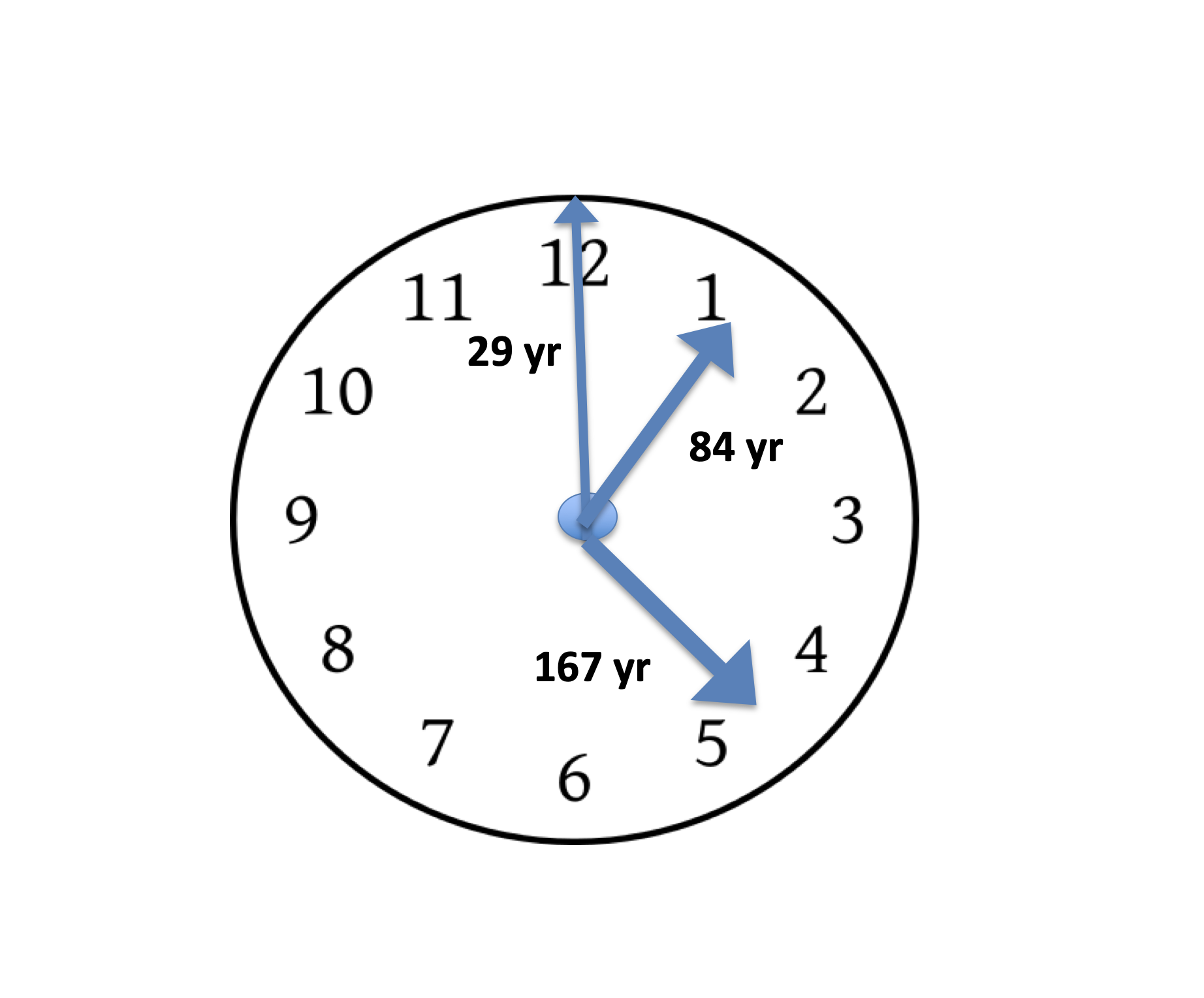The Solar Irradiation Clock (SIC) is turning, The Winter is Coming. SIC is a Total Solar Irradiation (TSI) indicator based on identified stationary periods in solar irradiation variability. TSI periods are related to the period- and phase-relation between the stationary periods of 29, 84 and 167 years.
SIC indicate a maximum solar irradiation, when the clock-periods have a maximum at the same time (at 12). SIC has a deep solar minimum when the clock-periods have a minimum state at the same time (at 6). The SIC is a simplified TSI model, computed form a chain of events, controlled by the large planets Saturn, Uranus and Neptune, the Solar barycenter oscillation, the Solar dynamo oscillation and to the TSI oscillation (Yndestad and Solheim, 2017).
The Solar Irradiation Clock State
Figure 2. Computed Solar Irradiation Clock Index state from 1000 to 2100 AD.
Known deep solar minima from 1000 A.D are: [Oort(1010-1070), Wolf(1270-1340), Spörer(1390-1550), Maunder(1640-1720), Dalton(1790-1820)] (Usoskin et al., 2014). Identified minimum from ACRIM TSI-HS date series are: [Oort(1040), Wolf(1337), Spörer(1547), Maunder(1714), Dalton(1810), Next (2049)] (Yndestad and Solheim, 2017). The Sola Irradiation Clock computes a TSI deep minimum at the years Itsi(min, t) = [Oort(1034), Wolf(1384), Spörer(1540), Maunder(1710), Dalton(1885), Next (2060), Next(2210)] (Figure 2). The Figure 2 show an upcoming Next deep solar minimum similar to a Spörer (1540) deep solar minimum.
The Solar Clock Phase Shifts
Figure 3. Solar Irradiation Clock computed wavelet phase spectrum from 1000 to 2200 AD.
A period phase spectrum shows the year when the period sum moves from a negative state and into a positive state. The phase spectrum then represents a “map” of long and short climate periods. Figure 3 show the Solar Irradiation Clock phase spectrum from 1000 to 2200 AD. The figure shows that SIC started new positive periods from the years 1745, 1918, 2080 and 2250. This indicates new positive solar irradiation periods from the years 1745, 1918 and 2080. Between 1920 and 2080, there was a solar period from 1918 to 1960 and a period from 1960 to 2080. From 1960 to 2080 there are a new set of periods.
The Solar Clock Power Specter
Figure 4. Solar Irradiation Clock computed wavelet power spectrum from 1500 to 2300 AD.
Figure 4 shows the computed SIC wavelet power spectrum from 1500 to 2300 AD. A period wavelet power spectrum shows expected power or impact from solar irradiation, computed from the Solar Irradiation Clock. The solar irradiation has a maximum impact at wavelet power maximum. The wavelet power period shows the period time when the solar irradiation has a positive or negative impact. Computed positive power spectrum periods are: [(1580-1674), (1749-1840), (1914-2004), (2080-2167)] and negative periods: [(1674-1749), (1840-1912), (2004-2080), (2167-2243)]. Positive wavelet power spectrum periods are expected to increase global Earth temperature. Negative wavelet power periods are expected to reduce global Earth temperature.
Mean Global Earth Temperature
Figure 5. Mean global Earth temperature (Tmp(Celsius)) from 1850 to 2016 AD.
Figure 5 show the mean global Earth temperature (HadCRUE4) from 1850 to 2016. The figure shows a cold period (1850-1916) and a warming period (1916-1999). The cold temperature period and SIC minimum power spectrum have a coincidence difference of (1916-1912) = 4 years. Increased global temperature and SIC positive power spectrum have the coincidence differences (1916-1914) and (2004-1999), a difference of only 2 and 5 years. A direct relation between the deterministic SIC power spectrum and recorded mean global temperature on Earth. The temperature reduction from 1940 to 1960 is related to the phase-relation between the 29-year period and the 84-year period.
The SIC wavelet power spectrum show an upcoming computed long-term global temperature reduction from 2004. The temperature reduction has a maximum speed in 2050 and a deep minimum in 2080. From 2080 the global temperature is turning into new warm period from 2120, when the SIC power spectrum has a new maximum. Global temperature will have next maximum in 2160, when the SIC power spectrum are turning into a negative direction. Between 1960 and 2160, the phase-relation between the 29-year period and the 84-year period introduces temporary minimum and maximum.
Summary
The Solar Irradiation Clock (SIC):
- Is a Total Solar Irradiation indicator based on identified stationary periods. The long stationary periods have a reference to the large planets Saturn, Uranus and Neptune.
- Shows a current irradiation maximum and computes an upcoming deep solar minimum at 2080.
- Power spectrum has a coincidence to mean global temperature from 1850.
- Computes a maximum temperature reduction at 2049, a next deep global temperature minimum at 2080, a next warm period from 2120 and a next maximum global temperature at 2167.
- Computed time to next global temperature maximum is: 2167-2004 = 163 years.
Presentations
This topic is covered in the following presentations:
- EGU2014: 20.04.2015. Vienna; 160418- EGU2016
- New Astronomy presentation: September 2016; 160926 NA-Paper
- EGU2018: 09.04.2018. Vienna; 180406 EGU2018
- Basic Science and Climate Change. 09.04.2018. Porto; 180904 Porto CC
- 12th International Conference on Climate and Energy.-24.09.2018, München; 181121 EIKE
References
- Yndestad, H., & Solheim, J. (2017). The influence of solar system oscillation on the variability of the total solar irradiance. New Astronomy, 51, 135–152. JP-NA-TSI 160828;
http://doi.org/10.1016/j.newast.2016.08.020 - The Solar Clock post: Solar Irradiation
- Usoskin, I.G., et al., 2014. Evidence for distinct modes of solar activity. As& A 562. L10. doi: 10.1051/0004-6361/201423391.

